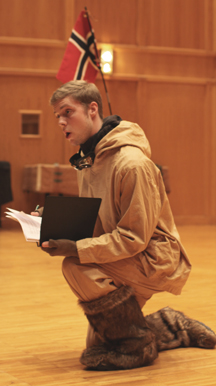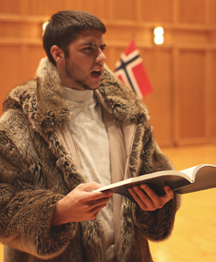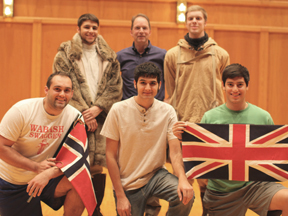The timing of Theater Professor Dwight Watson’s production of
Terra Nova last year was coincidental, but the results were far-reaching. Little did he know at the time of the production that the American National History Museum had planned a significant exhibition dedicated to the race to the South Pole, which is the subject of
Terra Nova.
When publicity was generated for Wabash’s production of Ted Tally’s play, officials at the Norwegian Consulate in New York contacted Professor Watson about the possibility of staging the play in New York to tie in with the opening of the exhibition.
While that collaboration never materialized, the
American Museum officials approached Watson about taking part in the exhibition’s special program devoted to explorers Roald Amundsen and Robert Falcon Scott, the two men who raced “to the end of the earth.”

Watson and Wabash students Adam Phipps
(below left), Geoffrey McKinney
(right), Jordan Plohr, Raynor Mendoza, and Alex Moseman will travel to New York City today to participate in a Wednesday night program that will be held at the famed museum.
The event will feature modern-day polar adventurers and scientists, who will discuss the historic race of 1911-12 and share unique insights on how it helped shape Antarctic exploration and science today.
Professor Watson’s students will present dramatic readings from original diaries featured in the Race to the End of the Earth exhibition at the museum. The program will be held on Wednesday, September 22 at 6:30 p.m. in the Kaufmann Theater at the American Natural History Museum. The event is free and open to the public. The exhibition will be open from 5:45 to 6:30 p.m. prior to the panel talk.
Amundsen, the Norwegian, used the latest technological advances and sled dogs to get to the South Pole first. Scott, a proud British officer, used only manpower, fought brutal weather, and arrived at the Pole only to discover the Norwegian flag planted in the frozen ground. Scott and his men perished while returning 800 miles to their base camp.
The readings the Wabash students will share come directly Amundsen’s book and from Scott’s journals, which were found after his death.
“We’re going to perform about eight minutes of readings in three different segments to set the tone for the discussion,” Professor Watson said. “We’re not doing the play; we’re performing the actual historical account of the explorers.”

The Wabash students’ readings will be interwoven with a critical look at the Heroic Age of Antarctic exploration by celebrated Antarctic skiers Liv Arnesen of Norway and Ann Bancroft of the United States, as well as by British Antarctic scientist Felicity Aston.
Watson said the first set of readings focus on the preparation and anticipation of the journey from the perspective of both men. The second set covers the journey itself, while the final readings showcase the sense of victory and defeat each man endured. The idea is for the students to inspire reflection on the part of the panelists.
In 2001, Bancroft and Arnesen were the first women to cross the Antarctic continent, and covered 1,717 miles on cross country skis in 97 days while documenting the journey on the web as part of an educational program.
Bancroft and Arnesen are presently mounting their next expedition — Access Water 2011, which is a worldwide effort to raise awareness of the fresh drinking water crisis in the poorest countries in the world. Their goal is to educate 50 million youth using a dynamic K-12 curriculum, and to inspire women and youth to take action.
To draw attention to the effort, the two women will join with six other female adventurers from six continents to ski across the continent of Antarctica. Their journey will be directly linked to classroom-based activities. Their past expeditions have resulted in more than two billion news media impressions.

Watson said his students’ journey to New York City will be packed with immersion learning-style activities. They will carefully study the Race to the End of the Earth exhibition at the museum, curated by noted scientist, Dr. Ross MacPhee; participate in the Race to the End of the Earth Revisited program; and attend a Broadway production.
“We’re taking four students who were directly involved in our production of Terra Nova and placing them in a well-regarded exhibition that will give them context for the work,” Watson said. “Our contribution to the exhibition is the public performance of passages from the writings of Amundsen and Scott and to support a truly remarkable panel. That will bring the kind of work we do into a broader conversation, which should be powerful for our students and the audience.”
About the NMNH Exhibition:
Race to the End of the Earth recounts one of the most stirring tales in the annals of Antarctic exploration, the contest to reach the South Pole. This exhibition focuses on the challenges that the two leaders — Roald Amundsen on the Norwegian side and Robert Falcon Scott on the British — faced as they undertook their separate 1,800-mile journeys from the edge of the Ross Ice Shelf to the South Pole and back.
The exhibit vividly re-creates, through dioramas and period detail, how Amundsen and Scott prepared for their polar journeys. Nutrition, human endurance, equipment, logistics, and Antarctica's extreme weather were among the many factors that each team had to evaluate, often with far too little information to avoid tragedy and ensure triumph. The exhibition also spotlights modern science in the Antarctic and its potential.
Photographs, paintings, and rare historical artifacts from these expeditions place visitors in the midst of Antarctic exploration and research at the dawn of the last century. Highlights include clothing and equipment used by both crews during their journeys; life-sized models of portions of their base camps; and a diorama featuring the largest penguin species alive today — the Emperor Penguin.
Hands-on activities help visitors of all ages understand what it would have been like to travel to the coldest place on Earth 100 years ago, as well as what it is like to conduct research there today. Visitors can choose a character card featuring a member of one of the expeditionary teams and, while moving through the show, find clues about the character's experiences on the way to the South Pole. With the aid of touch-screen exhibits, visitors can explore photographs, drawings, and documents relating to the expeditions and the men who went south with Scott and Amundsen.
The section on modern scientific studies in the Antarctic opens with a stunning video projection showing the rich underwater life that dwells in Antarctic waters. An interactive digital map of Antarctica allows visitors to scan the land that lies underneath the ice and to visualize ocean currents and weather systems. Visitors can also take a fun personality test to imagine how they might fare in an extreme environment over long periods of isolation.
Additional interactive exhibits and hands-on activities reveal what scientists are learning about Antarctica's ancient past and how people manage to live year-round in this forbidding yet fascinating place.
 Watson and Wabash students Adam Phipps (below left), Geoffrey McKinney (right), Jordan Plohr, Raynor Mendoza, and Alex Moseman will travel to New York City today to participate in a Wednesday night program that will be held at the famed museum.
Watson and Wabash students Adam Phipps (below left), Geoffrey McKinney (right), Jordan Plohr, Raynor Mendoza, and Alex Moseman will travel to New York City today to participate in a Wednesday night program that will be held at the famed museum. The Wabash students’ readings will be interwoven with a critical look at the Heroic Age of Antarctic exploration by celebrated Antarctic skiers Liv Arnesen of Norway and Ann Bancroft of the United States, as well as by British Antarctic scientist Felicity Aston.
The Wabash students’ readings will be interwoven with a critical look at the Heroic Age of Antarctic exploration by celebrated Antarctic skiers Liv Arnesen of Norway and Ann Bancroft of the United States, as well as by British Antarctic scientist Felicity Aston. Watson said his students’ journey to New York City will be packed with immersion learning-style activities. They will carefully study the Race to the End of the Earth exhibition at the museum, curated by noted scientist, Dr. Ross MacPhee; participate in the Race to the End of the Earth Revisited program; and attend a Broadway production.
Watson said his students’ journey to New York City will be packed with immersion learning-style activities. They will carefully study the Race to the End of the Earth exhibition at the museum, curated by noted scientist, Dr. Ross MacPhee; participate in the Race to the End of the Earth Revisited program; and attend a Broadway production.